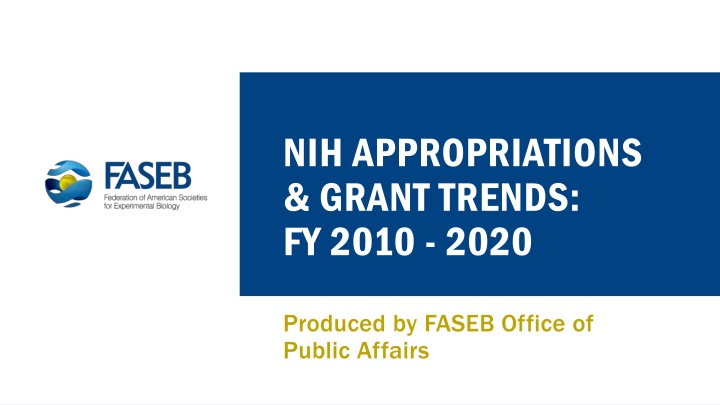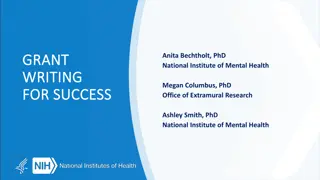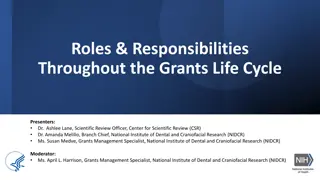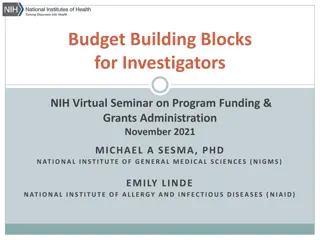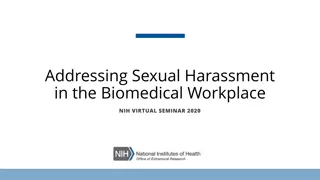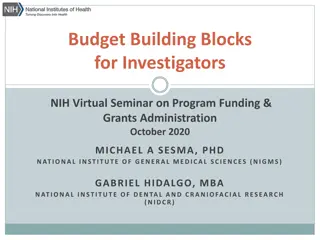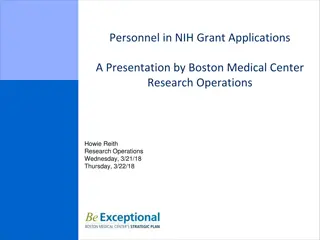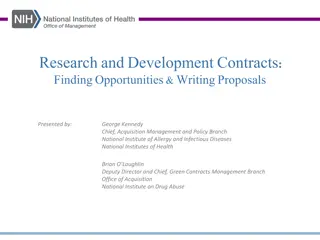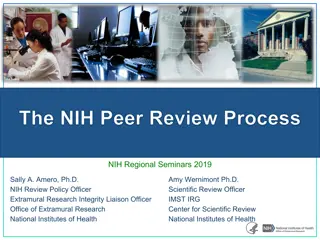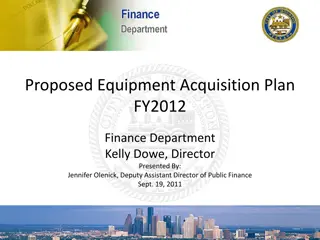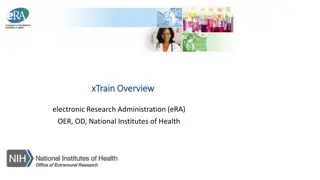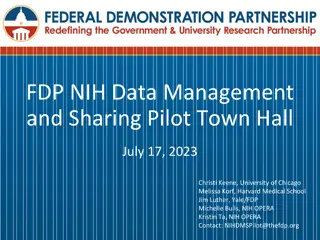NIH Appropriations and Grant Trends FY 2010-2020 Overview
Comprehensive overview of NIH appropriations and grant trends from FY 2010 to 2020, highlighting budget changes, inflation adjustments, funding increases, research project grants, and the impact on research capacity and funding distribution.
Download Presentation

Please find below an Image/Link to download the presentation.
The content on the website is provided AS IS for your information and personal use only. It may not be sold, licensed, or shared on other websites without obtaining consent from the author.If you encounter any issues during the download, it is possible that the publisher has removed the file from their server.
You are allowed to download the files provided on this website for personal or commercial use, subject to the condition that they are used lawfully. All files are the property of their respective owners.
The content on the website is provided AS IS for your information and personal use only. It may not be sold, licensed, or shared on other websites without obtaining consent from the author.
E N D
Presentation Transcript
NIH APPROPRIATIONS & GRANT TRENDS: FY 2010 - 2020 Produced by FASEB Office of Public Affairs
NIH Appropriations: 2010 Present 50 The FY 2020 NIH budget is $41.6 billion ($2.3 billion increase) 5.9% increase 3.3% inflation-adjusted increase President s FY 2021 Budget Request: $38.7 billion, an effective cut of 9.2% after adjusting for inflation FASEB s FY 2021 Recommendation: At least $44.7 billion 7.4% increase 4.8% inflation-adjusted increase FASEB Rec. $44.7 45 President s Budget Request $38.7 40 NIH Appropriations, Billions Actual Dollars FASEB Rec. $35.1 35 President s Budget Request $30.4 30 Inflation-Adjusted Dollars (2010) 25 FASEB Rec. $21.0 20 President s Budget Request $18.1 15 Inflation-Adjusted Dollars (1995) 10 5 0 2010 2011 2012 2013 2014 2015 2016 2017 2018 2019 2020 2021 2022 Appropriations data track total programmatic level funding, including Superfund activities and PHS evaluation funds. Inflation-adjusted (constant) dollars were calculated using the Biomedical Research and Development Price Index (BRDPI). Sources: NIH Office of Budget, Appropriations History, Price Indexes, and Budget Request; FASEB Annual Federal Funding Recommendations
NIH Appropriations: Budget Increases Increases in NIH appropriations have helped maintain and grow research capacity by: Offsetting inflation: ~$1 billion is needed annually to replace inflationary losses (assuming rates of 2-3%) Increasing research funding Research Project Grants 1780 more in FY 2019 1458 more in FY 2020 Trainee Awards (F- awards) 100 more in FY 2019 24 more in FY 2020 Continuing to support other research programs and infrastructure 3 Additional Research Funding Inflation Offset Increase in NIH Appropriations, Billions 2 $1.34 billion (57.7%) $1.22 billion (60.9%) 1 $0.98 billion (42.3%) $0.78 billion (39.1%) 0 2019 2020 Sources: NIH Office of Budget, Appropriations History, Price Indexes, and Historical Budget Requests; NIH RePORTER
NIH Grants: Research Project Grant (RPG) Funding 25 Noncompeting Research Project Grants (RPGs) support a defined research project and includes ~50 different activity codes (grant categories) RPG funding has closely tracked the NIH budget Since FY 1995, RPG funding constitutes 50- 56% of the NIH budget The proportion of funding for new and competing awards has increased due to greater use of shorter- term awards (e.g., the R21 activity code) Competing Revision or Supplement New Total Funding, inflation- adjusted (1995) Total Funding, inflation- adjusted (2010) 20 RPG Funding, Billions 15 10 5 0 2010 2011 2012 2013 2014 2015 2016 2017 2018 2019 2020 Only includes non-SBIR/STTR funding. Does not include sub project funding. Type 1 awards are New ; types 2, 4, and 9 awards are Competing ; type 3 awards are Revision or Supplement; and types 4, 5, 6, 7, and 8 are Noncompeting . FY 2010 data includes ARRA funding. Source: NIH RePORTER
NIH Grants: Number of Research Project Grants (RPGs) Competing Revision or Supplement Noncompeting 45 The number of RPG awards has risen and fallen with NIH s funding capacity Since FY 2015, the number of active RPGs has increased by 12% while the inflation-adjusted NIH budget rose by 14% for this same period New 40 Number of RPG Projects, Thousands 35 30 25 20 15 10 5 0 2010 2011 2012 2013 2014 2015 2016 2017 2018 2019 2020 Only includes non-SBIR/STTR funding. Does not include sub project funding. Type 1 awards are New ; types 2, 4, and 9 awards are Competing ; type 3 awards are Revision or Supplement; and types 4, 5, 6, 7, and 8 are Noncompeting . FY 2010 data includes ARRA funding. Source: NIH RePORTER
NIH Grants: R01-Equivalent Grant Funding 20 Noncompeting R01-Equivalent (R01-Eq) grants are considered the gold standard of NIH awards and provide multi- year funding for a research project, many of which are investigator-initiated R01-Eq funding constitutes 65-79% of RPG funding The amount of funding for R01-Eq rewards recently increased due to the addition of six grant types (activity codes) in FY 2018 Competing Revision or Supplement New Total Funding, inflation- adjusted (1995) Total Funding, inflation- adjusted (2010) 18 16 R01-Eq Funding, Billions 14 12 10 8 6 4 2 0 2010 2011 2012 2013 2014 2015 2016 2017 2018 2019 2020 R01-Equivalent awards include DP1, DP2, DP5, R01, R23, R29, R35, R37, RF1, RL1, and U01 activity codes. Does not include sub project funding. Type 1 awards are New ; types 2, 4, and 9 awards are Competing ; type 3 awards are Revision or Supplement; and types 4, 5, 6, 7, and 8 are Noncompeting . FY 2010 data includes ARRA funding. Source: NIH RePORTER
NIH Grants: Number of R01-Equivalent Grants Competing Revision or Supplement 40 Noncompeting The number of R01-Eq awards has mirrored NIH s funding capacity The number of R01-Eq awards also increased due to the definition change in FY 2018 New Number of R01-Eq Projects, Thousands 35 30 25 20 15 10 5 0 2010 2011 2012 2013 2014 2015 2016 2017 2018 2019 2020 R01-Equivalent awards include DP1, DP2, DP5, R01, R23, R29, R35, R37, RF1, RL1, and U01 activity codes. Does not include sub project funding. Type 1 awards are New ; types 2, 4, and 9 awards are Competing ; type 3 awards are Revision or Supplement; and types 4, 5, 6, 7, and 8 are Noncompeting . FY 2010 data includes ARRA funding. Source: NIH RePORTER
NIH Grants: R01-Eq Awards to First-Time Investigators 7000 First-time R01-Eq awards measure the number of R01-Eq awards made to applicants who have not previously received an R01-Eq award (i.e., new investigators) and constitute 22-29% of all R01-Eq awards The number of first-time awards in the past decade has been more stable than the number of R01-Eq awards overall, reflecting NIH s commitment to bring new investigators into the workforce, even when funding is constrained First Time Contact PI Established Contact PI 6000 Number of Type 1 R01-Eq Awards 5000 4000 3000 2000 1000 0 2010 2011 2012 2013 2014 2015 2016 2017 2018 2019 R01-Equivalent awards include DP1, DP2, DP5, R01, R23, R29, R35, R37, RF1, RL1, and U01 activity codes. First-time recipients measure the number of awarded applications submitted by investigators who had not previously received an R01-Eq award. First-time status only applies to the Contact Principal Investigator. Source: NIH Data Book
NIH Grants: Success Rates 25% Success rates measure the likelihood of a grant application being awarded funding and is currently around 20% for RPG and R01-Eq awards The success rate for first- time R01-Eq awards has been lower than the overall R01-Eq success rate since 2010 Success rates for FY 2019: RPGs: 20% R01-Eq: 21% First-time R01-Eq: 18% 20% Success Rate 15% 10% RPG R01-Equivalent 5% First-Time R01-Equivalent 0% 2010 2011 2012 2013 2014 2015 2016 2017 2018 2019 2020 NIH calculates success rates by dividing the number of competing applications funded by the sum of the total number of competing applications reviewed and the number of funded carryovers. Rates are calculated on a fiscal year basis and include scored and unscored applications. If an unsuccessful application is resubmitted that same fiscal year, it is only counted once in the denominator. Source: NIH Data Book
NIH Grants: Funding Rates 35% Funding rates measure the likelihood of an investigator having at least one of their applications awarded Funding rates for FY 2019: RPG: 29% R01-Eq: 28% First-Time R01-Eq: 22% Generally, success and funding rates rise and fall together, but funding rates are higher than success rates because investigators can submit more than one application per year 30% 25% Funding Rate 20% 15% RPG 10% R01-Equivalent 5% First-Time R01-Equivalent 0% 2010 2011 2012 2013 2014 2015 2016 2017 2018 2019 2020 The funding rate measures the percentage of applicants that received at least one award in that fiscal year. The two types of rates measure distinct (but related) outcomes; success rates measure the likelihood of an application received funding, while funding rates measure the likelihood of an applicant (investigator) receiving funding. Source: NIH Data Book
Untapped Capacity in the Biomedical Workforce Applications 25% Since FY 2010, there has been a cumulative increase of 19% for the number of RPG applications 18% for the number of investigators applying for RPGs In the same time period, NIH appropriations has only increased by 3.7%, after adjusting for inflation NIH funding has not kept pace with the increase in new applications, leaving exciting science unfunded Applicants 20% Cumulative Change Since 2010 Inflation-Adjusted NIH Appropriations 15% 10% 5% 0% -5% -10% -15% 2010 2011 2012 2013 2014 2015 2016 2017 2018 2019 2020 Cumulative percent change measures the percent difference in appropriations, applications, or applicants for the year in question as compared to the number in FY 2010. Source: NIH Data Book
